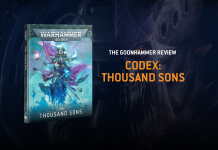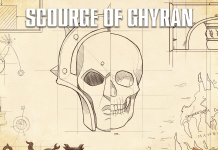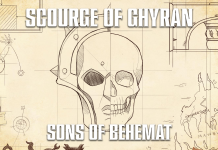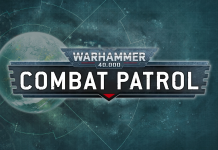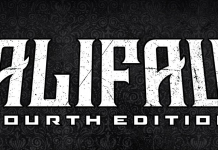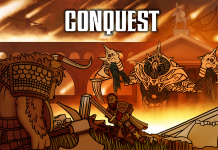The Thousand Sons were “blessed” with one of the early codexes in 8th edition, a book that was relatively weak from the jump even by 8th edition standards, despite having access to Ahriman and Magnus, two of the game’s most powerful units. As a standalone force the army tended to hover around the lower tiers of playability, typically showing up in souped Chaos Space Marine lists with an Ahriman-led detachment – often a Supreme Command – supporting other Chaos Space Marines. Ritual of the Damned improved the army’s lot considerably but following the release of 9th edition and the loss of the ability to ignore escalating Smite costs, there was little to recommend in the army beyond Magnus and Ahriman.
With this new Codex, the Thousand Sons have been given a fresh start. Designed from the ground-up for 9th edition, we finally have a view of the Thousand Sons that takes the edition’s new rules into account and incorporates the ideas from Psychic Awakening around Great Cults. But how does the book stand up to the current batch of codexes? Is it another broken, overpowered book ready to dominate the meta, or something less dramatic? In this review we’ll dive deep into the new book and answer these questions and more.
Before we begin however we’d like to extend a large “thank you” to Games Workshop for providing us with a preview copy of the Codex for this review.
Why Play Thousand Sons?
Thousand Sons are a very particular side of Chaos: A group of Chaos Space Marines dedicated to Tzeentch, led by sorcerers and staffed mainly by mutated beastmen and automated suits of armor filled with the dusty remains of their former inhabitants. The army leans heavily into Psychic powers, with almost every unit of infantry in the army having access to Psychic powers and most of the army’s tricks revolving around dealing mortal wounds and pulling off shenanigans in the Psychic phase.
As an army, Thousand Sons are a bit tougher than standard Chaos Space Marines but much less durable than Death Guard. They make up for this by generally having more damaging weapons and the ability to spit out mortal wounds through psychic powers, making them a bit more like glass cannons. If you’re playing Thousand Sons, it’s because the idea of running an army of sorcerers that gets most of its work done in the psychic phase appeals to you. And also because you want your army to have the aesthetic sensibilities of a prog metal album cover.
What’s in this Book?
- Lore for the Thousand Sons
- Army special rules for fielding a Thousand Sons list, with rules for the Nine Great Cults of the Legion
- Warlord traits, stratagems, relics, and a dedicated set of Secondary Objectives
- Two Psychic Disciplines – The Discipline of Change and the Discipline of Vengeance, each with 9 psychic powers
- Rules for the army’s units, including one new unit, the Infernal Master
- Magnus the Red, in all his fabulous, nipple-horned glory
- Crusade rules which tell the story of your army and your sorcerous cabal’s rise in the esteem of Tzeentch as they plot and scheme their way to victory
The Five Best Things About This Book
- The Space Wizards. If you’re a fan of herohammer, this book is going to be right up your alley – the Thousand Sons revolve around their psykers, and while most of them are in the HQ slot, the book gives you a couple of ways to stuff more in than a standard Detachment will allow.
- Psychic Powers. There are 27 powers in this book, between the 18 in the two main disciplines and the 9 from the Cults, and there are some incredibly strong powers in this set. Even your basic aspiring sorcerers will know three powers and they’ll be able to choose from 9 options on that third power. It’s a lot.
- Daemon Engines. The Death Guard kind of have their own daemon engines to worry about and so as a result we really didn’t get to see what most of the CSM datasheets would look like updated for 9th. With Thousand Sons we get a good look at the new datasheets for Maulerfiends, Forgefiends, and Heldrakes, and they’re all significantly improved.
- Magnus. Magnus returns in this book and he’s a total beast. He’s cheaper than before and while he’s not as resilient or as much of a combat monster as Mortarion, he’s pretty deadly in his own right and he’s much more of a force multiplier, with several ways to heal himself if he takes damage and isn’t killed.
- The Infernal Master. The new unit is a kind of combination sorcerer and dark apostle, with a bunch of very cool debuff effects for enemy units. It’s a cool concept and he brings a lot of additional “oomph” to the army
Where’s Crusade?
As ever, our initial review here is going to focus on the datasheets and matched play rules. Check back in next week for a dedicated review of all the Crusade rules in Codex: Thousand Sons..

The Rules
Each iteration of the Thousand Sons since 7th edition has brought them closer to being a fully fledged army in their own right and while they don’t have quite as many custom or unique kits as Death Guard, they now have a large enough number of rules and stratagems to feel wholly distinct from their regular Traitor Legionnaire brethren.
Detachment Rules
Thousand Sons detachments are now subject to three rules:
- Brotherhood of Sorcerers, which gives units in the detachment +1 to their Psychic Tests and gives ARCANA ASTARTES (Marines) and BRAY (Tzaangor) units a 5+ invulnerable save.
- Mere Servants, which limits Cultists and Bray units to one each per unit of Rubric Marines or Scarab Occult Terminators in the Detachment.
- Jealous Tyrant, which limits you to one Daemon Prince per Thousand Sons Detachment.
The adjustment to Brotherhood of Sorcerers is a huge improvement over the 8th edition rule which added 6” to the range of manifested powers, and for many of the returning powers in the Codex, the range of the powers have been improved such that you won’t notice a decrease in efficacy. +1 to cast helps give you an extra “free” Smite cast per turn and smoothes the difficulty curve for manifesting powers and performing psychic actions, though you’ll notice some powers have now increased in difficulty to compensate.
Mere Servants and Jealous Tyrant are less of a surprise here after Codex: Death Guard, which put similar rules in place for Poxwalkers, Cultists, and Lords of the Death Guard.
On top of that, Rubric, Bray, and Scarab Occult Terminators all get ObSec in Thousand Sons detachments, which is a huge bonus for the Terminators. We’ll talk more about them in a moment but they’re even more of a standout unit for the Thousand Sons now.
Legion Command
Character models in Thousand Sons Detachments now have access to Legion Command upgrades, special upgrades that can be purchased for different points totals in a similar fashion to Chapter Command upgrades or Deadly Pathogens. Each of these upgrades has different restrictions on what models it can apply to, and the effects range in cost from +10 to +35 points. They also vary pretty wildly in power. My favorite of them is likely Loyal Thrall (+15), an upgrade for a Sorcerer or Terminator Sorcerer that allows the character to attempt a Psychic Action instead of manifesting one psychic power, allowing you to perform an action and cast one of your regular powers – a pretty big bonus. Likewise, Ardent Automata (+20) goes on a squad’s Aspiring Sorcerer or Scarab Sorcerer and lets the model’s unit perform actions and shoot. Then there’s Rites of Coalescence (+15), a surefire hit in a large Scarab Squad, which heals another model in the unit to full every Command phase.
Cults of the Legion
First introduced in Psychic Awakening: Ritual of the Damned, Cults act as the subfactions of the Thousand Sons, giving you nine different options to choose from. Rather than having passive rules that apply to models in the Cult however, psykers in the cult know an extra psychic power – the one associated with their cult. It’s a powerful bonus, particularly for units of Rubrics and Scarab Occult Terminators that often want more to do than just Smite.
The Nine Cults from Ritual of the Damned return here in Codex: Thousand Sons and for the most part, they’re unchanged from those initial iterations. There are a few key differences – some powers have longer ranges and higher warp charge costs to match the new detachment rules – and the Cult of Magic has been toned down a bit. Astral Blast returns mostly unchanged, but the Devastating Sorcery Warlord Trait now gives re-rolls on Psychic Tests to manifest Smite or Witchfire powers, while Arcane Focus gives the bearer the ability to use Cabbalistic Rituals on a unit for 1 fewer Cabal points.
Of these cults, the Cult of Duplicity and the Cult of Scheming look much more interesting than they did before, with the former giving you a power to teleport units around the table and the latter giving you a power to Fall Back and shoot and charge and a Warlord Trait to give ObSec to any unit. The Cult of Magic remains strong, though no longer the slam-dunk it was. And the Cult of Manipulation is now much more interesting – the Warlord Trait now prevents re-rolls on hits, wounds, and damage against your Warlord, while Sorthis’ Mirror now lets you make close combat attacks with the unit you target rather than just letting you mimic their weapon.
Cabbalistic Rituals
The new monofaction bonus for Thousand Sons is Cabbalistic Rituals. If your entire army is made up of only Thousand Sons units, then at the start of each of your Psychic phases you generate a number of Cabal points for each unit in your army that’s on the battlefield. These very by model, but weaker psykers like your Aspiring Sorcerers generate 1 while Exalted Sorcerers and Ahriman generate 3 and Magnus generates 4 all by his lonesome. These points go away at the end of the phase if you don’t use them, but before then you can spend them on any one of 9 effects that apply to a unit in your army (a unit can only benefit from a single Ritual per turn). These range from adding 6” to a power’s range or tacking on another D3 mortal wounds to the damage inflicted for 4 Cabal Points, to auto-passing a manifest test at the minimum value for 7 points or adding 2 to your Psychic test after the fact for 9 points.
These effects are incredibly powerful and will likely form the backbone of what Thousand Sons armies want to do, which is crap out so many mortal wounds that they’re able to deal with virtually any threat. And at a minimum you can spend 4 CP to trade a unit’s psychic phase for a command point, which is a decent trade as well. Generally speaking we expect Thousand Sons armies – particularly those running Magnus – to generate a dozen or more Cabal Points per turn in the early game, powering out a large number of effects. The effects are also great for making sure you can guarantee powers like Weaver of Fates will go off, protecting key units.

The New Secondary Objectives
As with every other 9th edition Codex, the Thousand Sons have received a set of their very own secondary objectives. Three of these are legitimately interesting and will likely all see play, while the fourth is good in the rare conditions you’ll use it.
- Mutate Landscape (Warpcraft) gives you a Psychic action that one Thousand Sons Psyker unit can attempt while it’s within range of an umutated objective marker. Complete the action and the marker is mutated and the WC of the action increases by 1 for the rest of the battle (it starts at 4). You score 3 VP for each mutated marker at the end of the battle. This gives the Thousand Sons their very own version of Spread the Sickness, albeit without the ability to take mortal wounds to guarantee a success. Still, it’s relatively easy to complete 3 times on most maps and as a result likely to be worth 9 VP in many games, making it a solid choice, particularly since Rubrics and Terminators can attempt it.
- Wrath of Magnus (No Mercy, No Respite) is possibly the strongest of the secondaries, but conditional: You can only take it if your opponent has a PSYKER in their army and it scores you 3 VP at the end of each battle round if more enemy models than friendlies were killed by psychic powers that turn. This is going to be trivial for a lot of Thousand Sons armies just based on their ability to dole out mortal wounds, and in a worst-case scenario may force opponents to attempt smites instead of defensive buffs to attempt to deny points. Given that Thousand Sons can get a 6” range boost on some of their powers, getting this off on turn 1, particularly going second, shouldn’t be too big an ask either. Against an army with a single utility psyker (imagine Space Marines with a single Librarian along to cast a couple of buff powers) this should be utterly trivial to score 12-15 on. You won’t take this every game but every game you take it it’s gonna be fire.
- Burn Empires (Shadow Operations) gives your army an action called Burn Empires that any number of infantry can perform at the end of your Movement phase while they’re within range of an unburned objective marker outside your deployment zone and there aren’t any enemy units nearby. The action completes either at the start of your next Command phase or the end of the game and you score 4 VP each time you complete the action. The “end of game” clause here is the big winner, making this something you could conceivably scoop in and score 12 VP on during the game’s final turn. The “outside your deployment zone” rider is going to be the thing that trips people up but this can be a real slam dunk on the Scouring, Retrieval Mission, and Overrun, and it’s a great secondary for your Tzaangors to take on.
- Sorcerous Prowess (Purge the Enemy) is the most conditional of the three secondary objectives but gives you some real old-school Abhor the Witch style scoring. This Secondary awards you 5 VP for every enemy Psyker Character and 3 VP for every other enemy Psyker killed by a Thousand Sons Psyker in your army during the psychic phase. It’s a big hoop to jump through but against some lists – and my mind is immediately drawn to Ork lists with visions of three Kill Rigs dancing in their heads – this is a relatively easy 10-15 VP waiting to happen.
Generally, I believe that these secondary objectives are about 50% of what will keep Thousand Sons afloat competitively. They give the army more to do with its psykers and help it stay ahead on scoring with an army that is otherwise filled with relatively pedestrian datasheets.
Warlord Traits
In addition to the nine Warlord Traits tied to the Grand Cults of the Thousand Sons, we have six generic traits, most of them returning from the prior Codex, with a few adjustments.
- Arrogance of Aeons now gives you the ability to benefit from an extra Cabbalistic Ritual per turn in addition to giving you re-rolls on Deny tests.
- Seeker of Shadows is a new addition, replacing High Magister. A Warlord with this trait rolls an extra D6 and drops the lowest when taking tests and generates an additional Cabal point per turn.
- Lord of Forbidden Lore still gives you access to an extra power, but if the warlord taking it is Magnus, he just knows all of the powers from every discipline he can access. We’ll come back to that in a moment.
- Otherworldly Presence has been nerfed significantly, going from a persistent 3+ invulnerable save to a once-per-battle ability you can activate before making a save that lasts until the end of the turn.
- Aetherstride now lets you move as though you have FLY.
For the characters, Ahriman keeps Otherworldly Presence, but if Magnus is your Warlord (and he has to be), he gets the Mortarion Treatment, and gets Arrogance of Aeons, Undying Form (-1 damage), and Lord of Forbidden Lore, meaning he’ll have access to all 18 psychic powers, re-rolls on deny attempts, and be able to double ritual himself. Pretty good!
Infernal Pacts
Also new to the Thousand Sons are Infernal Pacts, which essentially function like prayers for the Thousand Sons, though the Infernal Master is not a PRIEST, and the effects of Infernal Pacts include more debuffs and have much longer ranges than prayers. There are six in total, with a few particular stand-outs: Bladed Maelstrom lets you pick an enemy within 30”, dealing it a mortal wound if it has 6+ models and giving it -2 to Advance and Charge rolls for a turn. This can be particularly handy when dealing with units that can Advance and Charge in the same turn, shaving 4” off their movement speed. Capering Imps targets a visible enemy unit within 24” and removes the benefits of Cover for them, while also taking away their ability to Overwatch or Set to Defend. And Glimpse of Eternity gives you a single re-roll of any one die not related to the mission until your next Command phase, making it a wonderful utility knife to have in your back pocket.
Almost all of these are worth playing with and the Infernal Master contributing to your Cabal points makes them a powerful new addition to the army. We’ll talk more about him later, though.
Relics
In addition to the Great Cult relics, the Thousand Sons have a host of new relics to play with that are available to any army, and if you’re looking for the Dark Matter Crystal, it returns under its new name, the Umbralefic Crystal, though its range for grabbing a unit is now 6” instead of 12. Most Thousand Sons players will remember that, beyond the Crystal, there wasn’t a whole lot of value in the meager six relics the faction had access to with the old codex. That has now changed, and some of these are really, really good.
The Athenaean Scrolls are back and have gone from being “maybe OK against some opponents on 1 in 6 casts” to being something you’d really want to look at, giving you a once-per-game ability to power up a single power the bearer knows, letting them roll 3D6 and drop the lowest when casting it. Similarly, almost every returning relic has been upgraded in some form or another.
Among the new stuff, the Conniving Plate immediately jumps out as a solid pick. This armor gives the bearer a 2+ save and prevents opponents from allocating more than half of their attacks to the bearer, while the Warpweave Mantle causes unmodified charges of 9+ against the bearer to fail and gives them +1 to Psychic tests if they’ve lost any wounds. And The Chronos Tutorum just lets you straight-up give the bearer a second Warlord Trait.
And that’s the tip of the iceberg – there’s a lot of stuff to pick from here, such that I think many armies are going to look hard at taking 2-3 extra relics every game, particularly when one can be added to certain characters for 35 points using the Legion Command upgrade Dilettante.

Psychic Powers
Alright, time to get to the real meat. The Thousand Sons have gone from three disciplines to two, though each of the disciplines they have access to now has 9 powers instead of 6. And while the Discipline of Tzeentch in the old Codex was tacked on from Codex: Daemons and only available to Daemon Princes and Magnus, the new Disciplines are fully available to all of the army’s Arcana Astartes psykers (Tzaangor Shamans are still locked into the Discipline of Change, but now get 9 powers to choose from). Additionally, some of the effects from the Discipline of Tzeentch have made it into these new disciplines.
The Discipline of Change
The Discipline of Change sees its five most popular spells return – Tzeentch’s Firestorm is back but at WC 6 and with a rider that an unmodified test of 9+ gives you mortals on 5+, making it significantly better. Glamour of Tzeentch and Weaver of Fates are both back, with the former getting easier to cast and the latter getting more difficult (though in effect, staying the same thanks to the +1 to cast bonus), though the latter now just gives you a 4+ invulnerable save. Doombolt just does 3 mortal wounds to the closest visible enemy now with no additional effects.
On the new side, Cacodaemonic Curse (WC 6) reduces the strength of ranged weapons in an enemy unit within 18” by 1 for a turn, while Perplex (WC 7) prevents an enemy unit within 24” from targeting enemy units more than 24” away with ranged attacks. And Pyric Flux (WC 5) replaces Flickering Flames’ effect with one that’s more useful, boosting the Strength of warpflame weapons in a friendly unit by 1 for a turn.
The Discipline of Vengeance
The Discipline of Vengeance is the modified version of the Dark Hereticus Discipline, incorporating those same spells plus three new ones to work with. If you’re wondering what the Dark Hereticus discipline is going to look like whenever Codex: Chaos Space Marines eventually releases, this is probably not a bad look, and many of the changes from the FAQ that lock effects to the Thousand Sons faction have already been incorporated here.
Infernal Gaze, Prescience, Diabolic Strength, Death Hex, Warptime and Gift of Chaos all return here essentially unchanged, though with new names and locked to the Thousand Sons faction where they can be used to buff friendly units. Though it’s worth noting that the new Warptime – Temporal Surge – is now limited to Infantry, Beasts, and Cavalry, meaning it can’t be used to double-move Magnus across the table anymore.
On the new side we have Empyric Guidance, Psychic Stalk, and Desecration of Worlds. Empyric Guidance and Desecration of Worlds are the better of these; the former boosts the range of Rapid Fire and Heavy weapons in a nearby friendly unit by 6”, while the latter curses a visible enemy unit within 24” and lets you roll a D6 for each model in the unit every time they make a normal move, advance, fall back, or charge and they take a mortal wound for every 6 they roll. It’s hilarious to picture on larger units, particularly those that might make multiple moves in a turn.

Stratagems
As one of the weird “not-quite-a-supplement” books in 8th edition the Thousand Sons always suffered from a dearth of usable stratagems, in part thanks to having to spend an entire column of them on Boon of Tzeentch. The new book gives us four pages of Stratagems to work through, including the standard suite we’ve come to expect from Marines, with stratagems for extra relics, warlord traits, a relic on a champion, smokescreening Rhinos, and making your Land Raiders shoot at full BS even when damaged. On top of that we have some things coming back from Ritual of the Damned and some all-new stratagems worth talking about.
The Returning Stuff
A few of these stratagems will be familiar to long-time players. Webway Infiltration and Risen Rubricae are both here, though both now have base costs of 2 CP to bring them more in line with the costs for Strategic Reserves. Yoked Automata returns as Selfless Automata and Infernal Fusillade returns, but now only gives +1 attack with your bolt weapons instead of letting you shoot twice. Fated Mutation also returns for Chaos Spawn, and with their new profile makes them worth more of a look. Great Sorcerer and Masters of the Immaterium are also here.
One of the more interesting changes is to Coruscating Beam, which returns here as the Thousand Sons’ Orbital Bombardment Stratagem, activated in your Command phase but not actually put into action until the following Command phase. Unlike other orbital bombardments however, the Stratagem has you draw a 9” line between your initial point and a new one of your choosing, allowing you to target the units on that line with potential mortal wounds on a 4+ – or a 3+, for units of 11 or more. The advantage of this is that it’s 1. Harder to run from, and 2. Can be dropped mid-table near an objective as you’re walking toward it, and you’ll be able to point the beam away once you arrive, protecting your own units while deterring enemies.
The New Stuff
There are some great new stratagems here to consider. Ensorcelled Infusion improves the AP of a vehicle’s ranged weapons by 1 while it’s within 6” of a friendly Psyker. Unwavering Phalanx reduces incoming damage on a Rubric or Scarab Terminator unit by 1 (Mike P: Dustingly Resilient?). Implacable Guardians makes a non-Magnus character untargetable while it’s within 3” of a friendly Rubrics or Scarab Terminators unit, and Malefic Scroll just straight-up causes Smite or another Witchfire power to do 3 mortal wounds instead of D3 – a very handy way to reduce variance.
Overall while the Thousand Sons certainly lost some power by having their new Veterans of the Long War replacement (Wrath of the Wronged) move to 2 CP and things like Indomitable Foes going away, they’ve gained more utility in their new stratagems and more offensive output overall. There’s more here that interacts meaningfully with psykers and fewer Killshot-style duds.it’s a decent set of stratagems to work from.
The Datasheets
Now we come to the datasheets. Even for a codex as small as Thousand Sons there’s a lot to cover here. We won’t cover everything in this review but we will talk about the Infernal Master, the major units, and some of the army’s key changes. And we’ll also put special attention on the daemon engines that will show up again later in Codex: Chaos Space Marines, since what we’re seeing now is likely to be the template for those later.
Note that, as with other books, pretty much every aura in this book has been adjusted to only work on Thousand Sons CORE units and most only affect <CULT> Core units.
Ahriman
Ahriman jumps 10 points over his prior incarnation, primarily because he’s gained an additional wound. Since the +1 to cast is now baked into his (and all other Thousand Sons sorcerers’) abilities, he can now re-roll psychic or deny the witch tests instead. He still casts three, denies three, and knows three powers and he generates 3 Cabal points for you each turn. Ahriman isn’t in a Cabal, but doesn’t mess up your detachment rules for Cabals.
The Thousand Sons Daemon Prince
Faster (12” with wings), Castier (2 points per turn), and a little bit luckier than his Death Guard counterpart (4+ invulnerable save), the Daemon Prince also generates 3 Cabal points and gets two casts per turn. There’s likely still enough value in taking the Thousand Sons Daemon Prince, particularly since little has changed for them.
Infernal Master
The new unit in the book, the Infernal Master is part sorcerer – he knows and can cast one power per turn while generating 2 Cabal points – and part chaplain – he knows two infernal pacts and can attempt to make one of them in each of your Command phases. This succeeds on a 3+, but you can use the Malignant Pact Stratagem if it fails to do a mortal wound to a nearby infantry or cavalry model to make it automatically succeed. Otherwise the Infernal Master is just a sorcerer, making him pretty fragile and mostly mediocre in combat. His real value comes from the buffs and debuffs he can put out. And at 90 points, he’s a steal.
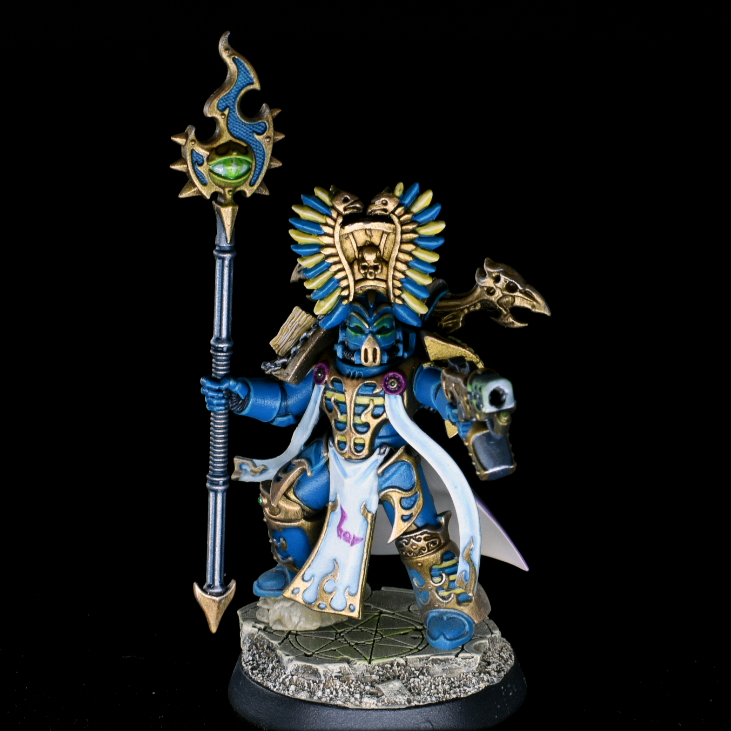
Sorcerers and Sorcerers in Terminator Armour
Both units return, albeit with an additional wound and now the Thrall rule, which allows you to include them in a Thousand Sons detachment without taking up a Battlefield Role slot if you’ve also got an Exalted Sorcerer in the detachment. This means that if your list includes 2 Exalted Sorcerers, it can also include 2 Sorcerers/Terminator Sorcerers (two total, not two of each), without taking up another Force Org slot.
Exalted Sorcerers
Exalted Sorcerers haven’t changed much; they’re about the same cost, albeit with one extra wound, and their discs of Tzeentch will cost you a few more points. They’re more important to take in monofaction armies however, as each one will unlock you a slot-free additional Sorcerer for generating Cabal Points.
Rubric Marines
The iconic, silent poster boys of the faction, Rubric Marines finally get their second wound as well as a second attack built-in to their profile in a fashion similar to Plague Marines. They also get a full 6” movement speed, but similar to Plague Marines can no longer go to 20 models per unit. All is Dust returns here as a rule, giving them the ability to ignore the penalty for moving and shooting heavy weapons and a +1 save against damage 1 weapons. This is an ability that’s kind of useful, but has lost a lot of utility as D2+ weapons have just shown up all over the place in 9th edition. It ends up being a lot less useful than Disgustingly Resilient, though Rubrics and Plague Marines both cost 21 points per model. Where Rubrics make up some of that discrepancy is being much better at shooting, with Inferno boltguns that are AP-2. This makes them significantly more effective at shooting targets to death from inside of 12” away, and with stratagems to count as remaining stationary you can make them more deadly at 24” away (the lack of ability to double shoot at full range after moving is a big blow here). They also pack a Sorcerer as a champion, adding some additional output in the form of psychic powers and mortal wounds that can be tossed out each turn. They can opt to take Warpflamers instead of bolters if you prefer, and the Soulreaper Cannon returns here in an improved form, now firing 5 shots at Strength 6, and finally of course they have the 5+ invulnerable save from Brotherhood of Sorcerers.
Rubrics aren’t nearly as durable as Plague Marines and they’re not really effective in melee but they can buff themselves in useful ways and they have some very strong mid-range shooting they can make use of. The unit gives you 1 cabal point and if you take an Icon of flame the unit will generate 2 per turn for you instead. Another new upside is that they’re immune to morale, which at least means never having to worry about losing models to attrition.
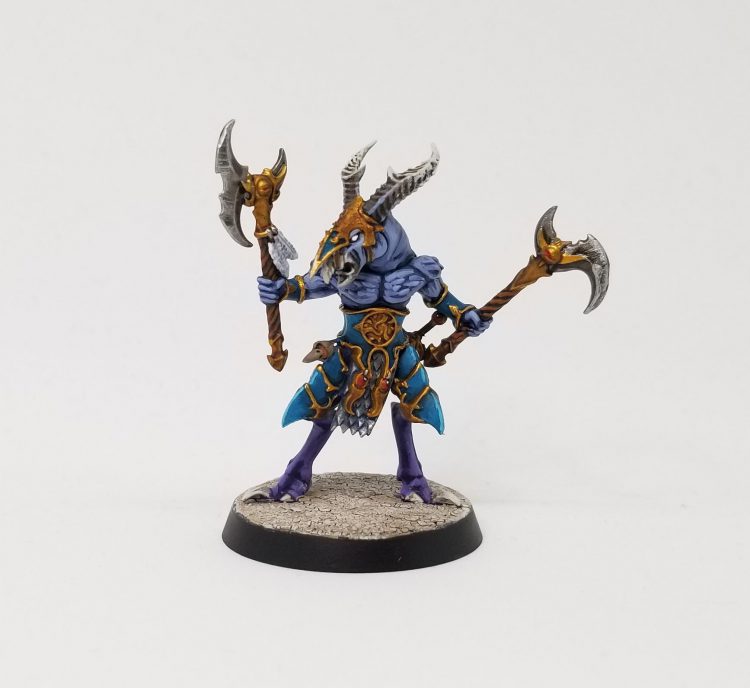
Tzaangors
Poor Tzaangors. They lost a ton of stratagem support and dropped to WS 4+ from 3+, and the army is now limited in how many you can include based on the number of rubric units. The only upside is that they now cost 7 points per model, making a 10-model squad of T4, 5+ invulnerable save models for holding objectives a pretty amazing deal. They aren’t as cheap as cultists, but the upgrade in durability is almost always going to be worth it. Just note: Tzaangors aren’t CORE.
Cultists
Cultists are 5 points per model and that is 100% of their value. Unlike in Death Guard where Poxwalkers can’t perform actions, Tzaangors are perfectly capable of doing so and so the real question is whether you have 20 extra points to spare on a huge upgrade in durability. There may also be some play in taking 30-model blobs for Thousand Sons, since Weaver of Fates and some other buffs can make them an absolute chore to burn through.

Helbrute
Helbrutes basically look like they did in Codex: Death Guard. If you were hoping for the non-Nurgle ones to keep their 8” movement well, prepare to be disappointed. Thousand Sons Helbrutes have Monstrous Resilience to reduce incoming damage by 1 and the ability to re-roll wound rolls of 1 if they’ve taken any damage. They do have a couple of things going for them over Death Guard Helbrutes however, in that there are buffs that can improve their accuracy such as Ensorcelled Infusion to give them +1 to hit, and as an ARCANA ASTARTES unit they enjoy a 5+ invulnerable save, which significantly boosts their durability. They might have some play as a result.
Scarab Occult Terminators
Similar to Rubric Marines, these guys get their extra wound and attack and, similar to Rubric Marines, they cost the same as their Death Guard counterparts, Blightlord Terminators (40 points per model). This leads to an even less flattering comparison, since they’re more vulnerable to D2+ weapons. They’re more resilient to 1-damage weapons, where they get a 1+ save, making them better off against say, Intercessors or Gauss Flayers, but with only a 5+ invulnerable save they’re just as likely to end up rolling 4+ saves or worse against the weapons that wreck them hardest. Again, they make up for this somewhat by being immune to attrition and having better shooting, though they arguably also have equal to or better melee than options than their Nurgley Brethren. And one area they do stand out as significantly better is that they have Objective Secured in Thousand Sons detachments, meaning that you can hold objectives much more easily with a smaller number of them, which is good for mitigating their durability.
Armed with AP-2 Inferno Combi-bolters, Scarab Occult Terminators can be absolutely devastating double-firing as they move up the table, and in a welcome surprise, have swapped out their power swords for a Prosperine Kopesh, a S+1, AP-3 D2 power sword, giving them 2-damage attacks in melee at a higher AP than Blightlords will traditionally get with axes. This makes them nearly twice as efficient at killing Marines and nearly as effective at taking out T3 4+ save targets, even when you factor in the wasted damage. On top of the extra melee oomph they pack better ranged weapons – the upgraded Soulreaper Cannon is superior in most ways to the Reaper Autocannon, and one model per five can pack a Hellfyre Missile rack for 2 more S8 AP-2 D3 damage shots.
Given the buffs that are available to them, it’s likely that every monofaction Thousand Sons army will want a 10-model unit of Scarabs, ideally to be blessed every turn with the Weaver of Fates psychic power to keep them safe and the Implacable Phalanx Stratagem to reduce incoming damage by 1 in a pinch (we’ll talk about this in a future Ruleshammer, since unlike chaff launchers in Lucius Ad Mech, you *do* get the bonus to your save for All is Dust after reducing the damage on an incoming attack to 1 with Implacable Phalanx). They’re a solid unit but one that will need a little more thought and finesse than Blightlords, and can’t be quite as disposable as their 2-wound CSM cousins.
Tzaangor Shaman
Tzaangor Shamans are notable in that they’re your only Elites slot psyker and as a result one of the more reliable ways of getting another 2 Cabal points per turn in your army. At 70 points they’ve gotten significantly cheaper (-15) from their prior iteration, and their auras no longer depend on CORE, and instead buff Bray or Enlightened units (they do not have these keywords themselves), but still give +1 to hit rolls within 6”.
I think Shamans will end up showing up in certain lists as an Elites source of Cabal points. I should also point out at this point that taking a disc of Tzeentch no longer confers the DAEMON keyword on your model, so RIP to that particular source of cross-book synergy.
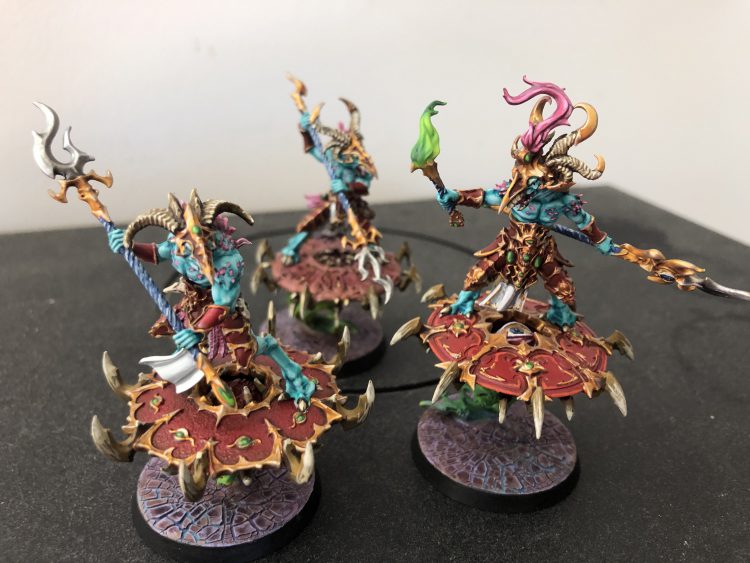
Tzaangor Enlightened
Enlightened return, and mercifully without losing a point of BS or WS. Their profiles are unchanged, but their weapons are not. In particular, Fatecaster Greatbows now have greater range – 30”, but are only Assault 1. That said, they can now ignore the Look Out, Sir rule and they automatically hit on unmodified rolls of 2+. That’s a pretty good tradeoff, but it now significantly changes the unit’s role, potentially making them a much more effective ranged unit for picking off characters, but before you get excited, note that six 1 damage shots, even at S5 and AP-1 will do, on average, 1.7 wounds to a Space Marine Librarian. The upside is that their Divining Spears are now flat 2 damage all the time, making them a little more effective in melee than they used to be. On the whole this is a unit Don Hooson and I have disagreed on during the review – he’s a much bigger fan of them as a cheap 10 wounds with T4 and the ability to hit things on a 2+ with ranged shots, but I’m just not sure they do enough for their points. As a cheap unit that can zip around and bother someone, they have some value.
Chaos Spawn
Chaos Spawn for Thousand Sons get the same upgraded profile here they got in Codex: Death Guard, moving to 2D3 attacks. They’re still cheap, and having a Stratagem to auto-pick which Mutation result you want makes them a little more interesting. They’re always going to be a solid way to spend your last 23 points.
Chaos Rhino
The Thousand Sons Rhino gets special mention here. It costs the same as its Death Guard counterpart but comes with an inferno combi-bolter and the option to take a second for 5 more points. More importantly, as a model with the ARCANA ASTARTES keyword, it benefits from the Brotherhood of Psykers Detachment ability, giving it a 5+ invulnerable save. That’s actually a pretty huge deal for the humble Rhino, and suddenly makes Rhinos full of Rubrics a much more attractive proposition. All hail the humble Rhino!
Chaos Predators, Vindicators, and Land Raiders
These are pretty much what you’d expect though it’s worth pointing out that they also have the ARCANA ASTARTES keyword and as a result, the 5+ invulnerable save.
Mutalith Vortex Beast
Ah the Mutalith. A unit everyone really, really wanted to be good but could never quite get there. I’m happy to say that the new Mutalith is a significant improvement over the old: It starts on 10” movement now and while its WS degrades with wounds (though it starts on a 3+ now instead of a 4+), its attacks no longer do so and it now heals D3 wounds each turn instead of 1, plus there are significantly more ways to heal it in the book between powers and stratagems. Add to that the Enormous claws are now S+1 AP-2, 3 damage, giving the beast S8 attacks, and you’ve got yourself a nasty little melee monster for the incredibly reasonable price of 145 points.
If that was all it had, it’d likely not make the cut for its price but now the Mutalith also gets the ability to manifest Vortex powers – 2 per turn at full health, and 1 if it has 4+ wounds remaining. It can’t manifest a power that has already been manifested by another beast this turn, so capping at 2 per army is likely to be the play. There are four options to choose from and each one gives your beast a way to spit out mortal wounds, with some being better against different targets and in different situations – Beam of Unreality can do D3 mortal wounds to a target with 10+ on a 3+ (or D6 if you roll a 5+), while Immaterial Fire rolls a D6 for each model in an enemy unit and does a mortal wound for every 6 rolled. The standard mode, Turbulent Discharge, is essentially a Smite that goes off on a 2+ and does flat 3 mortals on a 5+.
In all this makes the Mutalith Vortex Beast a rather tasty option; its biggest downside is being worth 2 VP for Bring it Down, but that’s likely not going to be an issue since you’re more likely going to be worried about Assassination most games. It’s going to be a fine source of mortal wounds with the ability to do some real damage if it gets stuck in melee. Which, with 10” movement now, it’s more equipped than ever to do.
Forgefiends and Maulerfiends
Alright children, sit up and take notes because what we’re getting here is basically going to be how the datasheets shake out for these two units in the future. Both Forgefiends and Maulerfiends got significant boosts in the new book, and it’s worth taking a good look at both because I think they’re both playable as hell now.
Forgefiends get a huge boost from jumping up to BS and WS 3+, though both degrade now along with their movement (attacks do not). That’s interesting because now that Forgefiends can shoot autocannons in melee and are S7 and 5A base, the prospect of getting them in combat with their standard jaws isn’t nearly as troubling. That said, their guns are also significantly improved now – Ectoplasma Cannons are 36” and flat 3 damage (Blast), while Heavy hades autocannons are 48” and AP-2 now, making both significantly better for dealing with heavy targets at a long distance.
Maulerfiends benefit even more from the improved statlines – they’re now S7 and 6A base, and now only their movement, WS, and BS degrade, with the latter two starting at 3+ so you won’t even feel the drop until you get down to 3 wounds remaining. Magma Cutters are now Assault 2 and do D6+2 damage, making them significantly better options, particularly since Lasher Tendrils have dropped to 1 damage (though being S7 does mean you’re more likely to get wounds). If you’re wondering why you would still take them, the answer is because you might not need Magma Cutters as Maulerfiend Fists are now D3+3 damage. Oh and the cherry on top of all of this? The new Siege Crawler ability, which allows the Maulerfiend to ignore all modifiers to its charge rolls. So roll right over that difficult terrain at your leisure.
Defilers
Defilers look like they did in Codex: Death Guard. They might be a little less disappointing here, since there’s no Disgustingly Resilient for them to not get, and they’re still better than they were at BS and WS 3+ to start, and the Defiler cannon now being flat 3 damage is a major upgrade. The Defiler Scourge isn’t quite as nasty as it used to be now that it’s 2 damage but it’s still an auto-take and the Claws will tear things up just fine if they have more wounds. The big upside to Defilers in Thousand Sons is that they aren’t competing with Plagueburst Crawlers, and that might make the difference for them, particularly since they can be BS 2+.
Heldrakes
Y’all. I am already assembling my next Thousand Sons Heldrake. This thing absolutely slaps. While we’re (sadly) back to the Heldrake being an AIRCRAFT instead of a big skimmer, it gains Hard to Hit while it’s in jet mode and 20-60” movement along with Supersonic and Airborne Predator, which prevents it from charging any non-AIRCRAFT units. Want the old Heldrake back? Then in your Command phase it can switch to Hover Jet mode, and its movement drops to 20” and it loses all three of those abilities, letting it attack ground targets. Either way, its Hunter in the Skies rule gives it +1 to hit any target that can FLY.
On the whole, these changes are slightly negative – the Heldrake can’t hold objectives any more, and you have to plan a bit more to use it, and it’s slightly slower, but it’s harder to hit and potentially faster when it wants to be. But the kicker is that its stats and offensive power are much better. In addition to having WS/BS 3+ to start like other vehicles and 5A base now (these do not degrade, by the way), every one of its weapons have improved. The Baleflamer is now Assault 2D3. The Hades Autocannon is AP-2. And the Heldrake Claws do a flat 2 damage, which jumps up to 4 against enemy AIRCRAFT, making the Heldrake an absolute monster for fighting enemy planes out of the sky. Sure, this won’t happen often, but it’s going to be hilarious when it does and even without it, he’s pretty good at fighting ground targets and jump units.
There’s one other thing worth mentioning here and that’s the Vector Strike Stratagem, another thing we’ll likely see again in the future Codex: CSM. For 1 CP Vector Strike can be used in the Movement phase after a Heldrake moves to pick an enemy unit it moved over that isn’t a character with 9 or fewer wounds and roll a D6; on a 2+ they take D3 mortal wounds… unless they can FLY, in which case they take 3 instead. Add this to the Warpflame Gargoyles Stratagem to do mortal wounds to enemy units within Engagement range and you’ve got yourself an incredibly nasty flyer that can also toss out more mortal wounds and pick off key targets. The Heldrake wins my award for “most improved unit” in the book.

Magnus
Alright, let’s talk about Big Red. Magnus is, for the most part, a big improvement over his prior incarnation from a pure abilities standpoint. He’s cheaper – 450 points, down 15 from before – and while there are definitely a few areas he’s going to feel inferior to how he used to be, he’s on the whole much improved. First let’s start with the good stuff:
- Three Warlord Traits. Magnus now gets three Warlord Traits, which means that as your warlord, he reduces incoming damage by 1, re-rolls his deny the witch tests, can get 2 Cabbalistic Rituals, and knows every power in the book. The downside is that he has to be your warlord to get these benefits.
- Supreme Commander. Magnus is a Supreme Commander and has to be your Warlord now, though if you want to cram him and Mortarion into a list, you have to pick one to be Warlord.
- Better Re-rolls. Magnus gets an aura to let Thousand Sons CORE units re-roll hit rolls of 1 within 6”, and he gets the Chapter Master ability to give a full re-rolls to hit aura to a CORE or CHARACTER unit within 6” during your Command phase. He previously only had a re-roll 1s to hit aura, but we’ll come back to that in a moment.
- Never Perils. Magnus never perils. That’s pretty much how it should be anyways.
- Better Psychic Tests. Magnus now re-rolls all his tests, and gets +2 to his tests if he has 10+ wounds left or +1 otherwise. Coupled with the Brotherhood of Psykers ability (he has the ARCANA ASTARTES keyword), this means Magnus starts with +3 to his tests and then drops to, at minimum, +2.
- Gaze of Magnus has a higher floor. When Magnus smites, he means it. He still does D6 mortals in baby mode, but jumps up to 3D3 if you roll an 11+. That’s going to give you fewer wounds on average (6) and a lower ceiling, but more consistency and a lower floor (3 vs. 2). Look for us to do a future Hammer of Math on this.
- Magnus is better in melee. He starts on 8 attacks now and degrades to 6, and the Blade of Magnus how does D3 mortal wounds to a single enemy model that lost wounds from the weapon but wasn’t destroyed after he fights.
So what’s not so great? Well, that 2D6 -> 3D3 transition for Gaze of Magnus isn’t ideal, and his aura won’t affect vehicles anymore, but that’s just the way things go in 9th edition. He can still cast/deny three powers, and if you don’t make him your warlord (such as if he’s paired up with Mortarion), he knows three he can cast, picked from either discipline. Also, he can’t be a target for the new Warptime, Temporal Surge, as he’s not one of Infantry/Beast/Cavalry.
Taken as a whole, Magnus feels a bit weaker than his brother Mortarion; he’s not quite as deadly in combat, owing to doing less damage per hit and not having a “sweep” mode to increase his attacks count, but he’s much, much more deadly with psychic powers and unlike with Mortarion, there are multiple ways to heal Magnus with powers and Stratagems, meaning he’s actually able to come back from losing wounds. Which is good, because lacking Mortarion’s 5+ Feel No Pain save on each point of damage means he’ll feel much more fragile much of the time, even with the 1-point reduction on incoming damage. It’ll be crucial to keep Magnus hidden until he can get up his psychic defenses but at 4 Cabal points per turn by himself. The result is a unit that I think is worth it, and is certainly better, but is still a bit underwhelming.
I’m glad I already had him painted, anyways.
Some Lists
Alright, now that we’ve gone through all that, what might we build with this new monstrosity?
This is my first stab at a list. It’s not a great list. Hell, it’s probably not even a good list. But what I do know is that 1. I have already painted Magnus, and 2. It’s going to take me several games playing with Cabal points before I get a good feel for how to use them and when, and how many I really want to generate each turn. My initial passes at building a list looked to maximize them, but generating 16-18 per turn left me without a lot else to play the field with. This new iteration brings that way down while giving me plenty to work with.
Rob’s “Look I Already painted Magnus and a Mutalith” List
+++ Thousand Sons Supreme Command Detachment (0 CP, 450 points) +++
LoW: Magnus the Red, Warlord: Arrogance of Aeons, Undying Form, Lord of Forbidden Lore
- Powers: Yes
+++ Thousand Sons Battalion Detachment (-2 CP CP, 1550 points) +++
Cult: Cult of Scheming
HQ: Exalted Sorcerer w/Infernal Bolt pistol, force stave (100)
- Trait: Grand Schemer (-1 CP)
- Relic: Egleighen’s Orrery
- Powers: Presage, Twist of Fate
HQ: Infernal Master (90)
- Pacts: Malefic Maelstrom, Glimpse of Eternity
- Powers: Empyric Guidance, Glamour of Tzeentch
NA: Sorcerer w/force stave, inferno bolt pistol(90)
- Extra Relic: Cha’Qi’Thil’s Theorem (-1 CP)
- Powers: Perplex, Cacodaemonic Curse
Troops: Rubric Marines x10 (210), Powers: Glamour of Tzeentch
Troops: Rubric Marines x5 (105), Powers: Temporal Manipulation
Troops: Cultists x10 (50)
Troops: Tzaangors x10 (70)
EL: Scarab Occult Terminators x10 (445)
- 5 w/Inferno combi-bolter + Prosperine Blade
- 2 w/Inferno bolter + Prosperine blade + Hellfyre missle rack
- 2 w/Soulreapper Cannon + prosperine blade
- Aspiring Sorcerer: Rites of Coalesence (+15), Powers: Weaver of Fates
DT: Rhino (80)
HS: Mutalith Vortex Beast (145)
FLY: Heldrake (165) w/Baleflamer
+++ 2,000 points, 10 CP +++
The idea here is that Magnus and the Scarabs are the key threats, with the latter being a large blob that can occupy the middle of the table. I *think* this list can be comfortable playing To the Last using Magnus, the Scarabs, and the unit of Rubrics in a Rhino, and if not I think Grind it Down is reasonable against some lists. It’s also well-equipped to tackle Warpcraft Secondaries or score Burn Empires with the Cultists and Tzaangors. The Cult of Scheming lets me max out utility with the Scarabs, letting them fall back and shoot and charge, while Cha’Qi’Thl’s Theorem will pay for itself the first time I use on the Scarabs to drop incoming damage by 1 on attacks against them (a 3 CP Stratagem on a 6+ model unit). The Mutalith and Heldrake are additional cheap harassment units that can take heat off Magnus or punish an opponent for ignoring them, but I’m also going to test Defilers and Forgefiends in here at some point. There’s also a
I also asked fellow resident Chaos (though primarily Death Guard) player Don Hooson to come up with a Thousand Sons list, and he threw this idea at me of a list that “would absolutely make his butthole pucker if he had to face it with his current vehicle-heavy Death Guard list.” The idea here is pretty simple: Toss out an insane number of mortal wounds while enjoying the protection offered by Rhinos.
Don’s List: Oops All Rhinos
+++ Thousand Sons Battalion Detachment (0 CP, 1,265 points) +++
Cult of Magic
HQ: Exalted Sorcerer (100)
HQ: Infernal Master (90)
Troops: Rubric Marines x5 with Soulreaper Cannon, Icon of Flame (125)
Troops: Rubric Marines x5 with Soulreaper Cannon, Icon of Flame (125)
Troops: Rubric Marines x5 with Soulreaper Cannon, Icon of Flame (125)
Troops: Rubric Marines x5 with Soulreaper Cannon, Icon of Flame (125)
Troops: Rubric Marines x5 with Soulreaper Cannon, Icon of Flame (125)
DT: Rhino w/Inferno Combi-Bolter, Inferno Combi-Melta (90)
DT: Rhino w/Inferno Combi-Bolter, Inferno Combi-Melta (90)
DT: Rhino w/Inferno Combi-Bolter, Inferno Combi-Melta (90)
DT: Rhino w/Inferno Combi-Bolter, Inferno Combi-Melta (90)
DT: Rhino w/Inferno Combi-Bolter, Inferno Combi-Melta (90)
+++ Thousand Sons Patrol Detachment (-2 CP, 735 Points)
Cult of Magic
HQ: Infernal Master (90)
Troops: Rubric Marines x5 with Soulreaper Cannon, Icon of Flame (125)
Troops: Rubric Marines x5 with Soulreaper Cannon, Icon of Flame (125)
Troops: Rubric Marines x5 with Soulreaper Cannon, Icon of Flame (125)
DT: Rhino w/Inferno Combi-Bolter, Inferno Combi-Melta (90)
DT: Rhino w/Inferno Combi-Bolter, Inferno Combi-Melta (90)
DT: Rhino w/Inferno Combi-Bolter, Inferno Combi-Melta (90)
+++ 2,000 points, 10 CP +++
That gives you a whopping 23 Cabal points to play with per turn, though note that the Rubrics will only generate those points when they’re on the table and out of the Rhinos. Speaking of which let’s talk about the large number of Rhinos that, in many ways, act as T7 5-man marine squads with a meltagun, pouring out 3-6 Inferno bolter rounds and a melta shot per turn with some additional protection thanks to the 5++ Brotherhood of Sorcerers save. The net effect is a surprisingly rangy list that can toss out an obscene number of mortal wounds per turn, as you’ve got 11 psykers in the army capable of casting Smite or whatever else you like and drowning out enemy targets in a deluge of wounds they can’t roll saves against. It’s an interesting list, and what I’d expect to see from Don given his preference for skew.lists.
I also asked Mike Pestilens, a notable Chaos Daemons player and author of the Warphammer blog, for his thoughts on a list, and here’s what he came up with, taking advantage of the Brotherhood of Sorcerers and the fact that units in the Imperial Armour Compendium gain access to the ARCANA ASTARTES keyword and, as a result, the 5+ invulnerable save.
Mike Pestilens’s List: Dusty Guns Never Tire (2000 Points, 7 CP)
Mike: We’re going to get weird for this one to show off some of the synergies available in the new codex. I think Thousand Sons can operate as a strong shooting army that also delivers a punch in the psychic phase, so we’re going to explore that here.
+++ Thousand Sons Battalion Detachment +++
HQ: Exalted Sorceror on Disk (WL, Undying Form, Conniving Plate, Dilettante – The Chronos Tutorum – Seeker After Shadows)
HQ: Exalted Sorceror (1 CP – Egleighen’s Orrery)
HQ: Infernal Master (Capering Imps)
Troop: 10 Rubric Marines (Icon of Flame, Ardent Automata)
Troop: 5 Rubric Marines
Troop: 10 Tzaangors (Blades)
Troop: 10 Tzaangors (Blades)
Elite: 5 Scarab Occult Terminators
Elite: Volkite Contemptor
Elite: Volkite Contemptor
Elite: Volkite Contemptor
Fast Attack: Dreadclaw Drop Pod
Flyer: Fire Raptor (Dual Quad Heavy Bolters)
With the free 5++ invuln available to all ARCANA ASTARTES units, I decided to take a look at vehicles without invulns and see if we can make any glass cannons into… slightly less glassy cannons. You know what unit would seriously love a free 5++ invuln? A Fire Raptor. Let’s give it a shot.
The Exalted Sorceror can take a 35 point upgrade called Dilettante to receive a free relic. Thousand Sons have a relic which let’s you pick an additional Warlord Trait. So we’re going to use that 35 point upgrade to buy a Warlord Trait in a roundabout way, partially because I think that’s funny and partially because I think that Exalted Sorceror becomes an excellent tool for playing the mission. He is supremely durable with -1 Damage and a 2+ save and halving enemy attacks, and rolls an additional dice when performing psychic actions. The aura from the Egleighen’s Orrery relic to ignore most modifiers (including damage modifiers!) along with the Infernal Master’s ability to ignore cover against an enemy unit will really supercharge the Volkite Contemptors. The stratagem to give a Vehicle +1AP on its shooting attacks will also help the Fire Raptor or Contemptors really deliver a powerful punch when needed. This all synergizes very well with the Cult of Knowledge free spell to reroll 1’s to Wound against a target.
Dreadclaw Drop Pods are primarily associated with Emperor’s Children, but I think there may be real play to putting 10 Rubric Marines in a Drop Pod. Give them the upgrade to perform actions and still shoot, and you have a unit that can come down anywhere to raise a banner or retrieve data while also delivering lots of AP2 firepower. Don’t forget that the Dreadclaw will have a 5++ invuln once it’s down, keeping it alive to fly around and do mortal wounds and drop flat 3 damage attacks in melee.
Final Verdict
On the whole, I really like Codex: Thousand Sons. It’s a hard book to gauge power-level wise, since it’s not clear how Cabal points will actually play without some test games, but it feels like a book with several good options and some sneaky good strategies. Ultimately if I have one complaint with that book it’s that there are some great secondaries, powers, stratagems, and relics here that are propping up an otherwise pedestrian set of datasheets – Rubrics and Scarabs are fine, but All is Dust doesn’t particularly excite these days and costing them the same as Plague Marines and Blightlords seems a bit mental.
But beyond that, the way the book is set up leaves me feeling pretty good about it. There are some strong monofaction bonuses here, Magnus is better than ever, and the book leaves the faction much, much better off than they were. I don’t believe it’s going to compete with Drukhari and Admech and Orks at the upper ranges of 70%+ win rates, but I do believe this will firmly bring Thousand Sons into the fold of “50 to 55% win rates,” and they’ll be particularly advantaged against armies that only bring one psyker for a couple of defensive buffs.
So overall I think this is a good book. It’s not Death Guard good – that book sets the standard for 9th edition books for me from an internal and external balance standpoint – but it’s not too far off and it doesn’t immediately strike me as full of broken insanity like the last few books. I’m just happy to get 5+ invulnerable save rhinos, really.
Have any questions or feedback? Drop us a note in the comments below or email us at contact@goonhammer.com.

